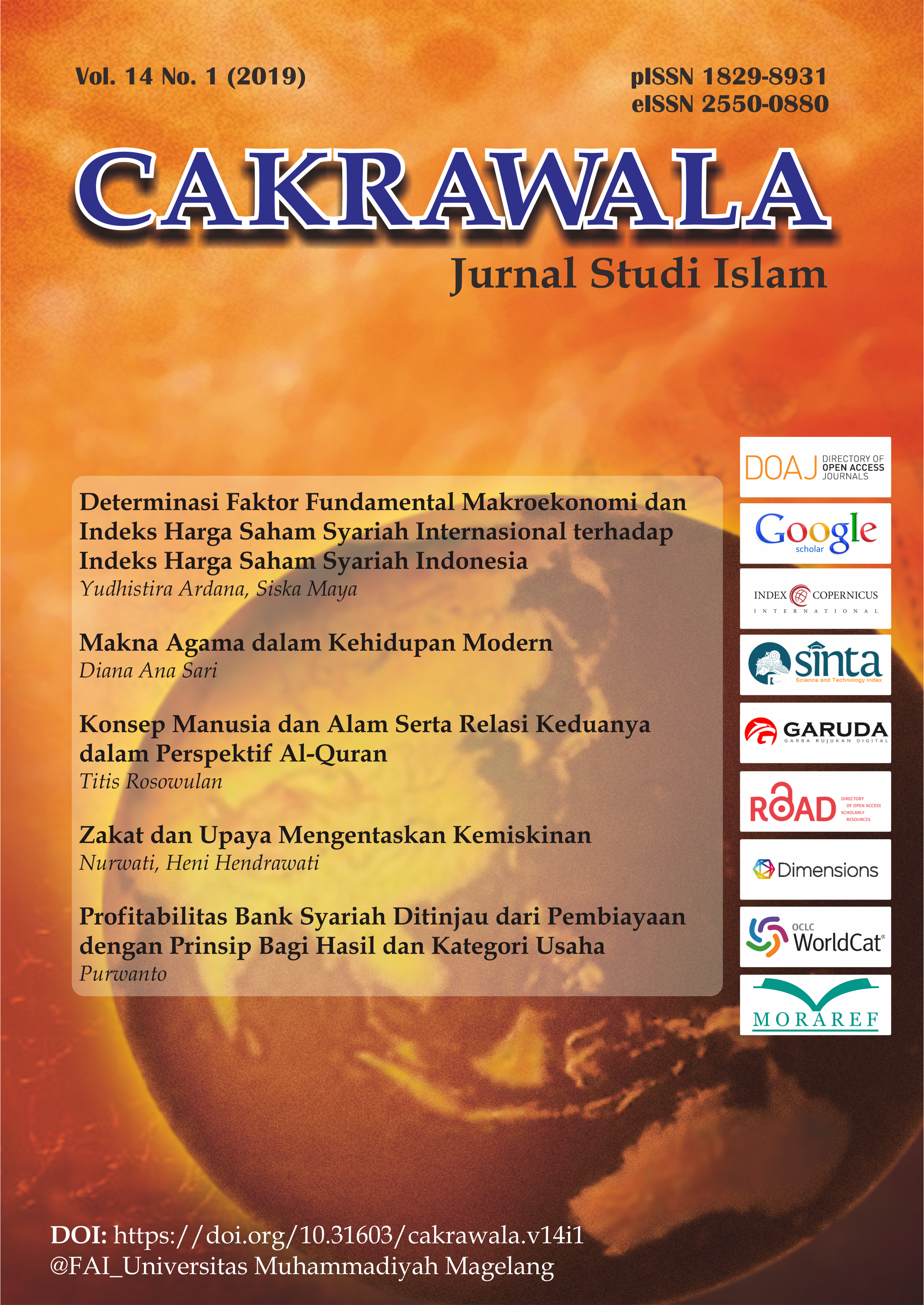Main Article Content
Abstract
As a business institution, the objectives of Islamic banking is profitability. The profit can be achieved if Islamic banking distributes financing both with the principle of buying and selling, profit sharing or services. The focus of the study was on financing with the principle of profit sharing (Mudharabah and Musyarakah). Profit sharing has been studied as a variable that can increase profitability, but there are no definite conclusions. Thus it is necessary to study whether the actual financing of profit sharing affects the level of profitability directly or through certain business categories. The type of research is causality research with a quantitative approach. The population is Sharia Commercial Banks and Sharia Business Units in the period of January 2016 to December 2018. The data analysis uses Partial Least Square (PLS). The results shows that financing with profit sharing principles is proven to directly have an influence on profitability but in a negative coefficient. This study also shows that the higher the profit sharing financing, the lower the level of profitability. However, when the revenue sharing is channeled through SMEs and non-SMEs, the results become positive and significant to profitability
Keywords
Article Details

This work is licensed under a Creative Commons Attribution-NonCommercial 4.0 International License.
References
- Abraham, R., & Harrington, C. (2013). Measuring Profit in Cooperatives : Definition and Methods. International of Business, Humanities and Technology, 3(4), 21–33.
- Afkar, T. (2017a). Influence Analysis Of Mudharabah Financing And Qardh Financing To The Profitability Of Islamic Banking. Asian Journal of Innovation and Entrepreneurship, 2(3), 340–351.
- Afkar, T. (2017b). Pengaruh Pembiayaan Usaha Mikro, Kecil, Menengah Mendapatkan Laba Dari Aset Perbankan Syariah Di Indonesia. Al-Uqud: Journal of Islamic Economics, 1(2), 183–201.
- Almanaseer, S. R., & Alslehat, Z. A. (2016). The Impact of Financing Revenues of the Banks on their Profitability : An Empirical Study on Local Jordanian Islamic banks. European Journal of Business and Management, 8(12), 195–202.
- Aqza, Y., & Darwanto. (2017). Pengaruh pembiayaan murabahah, musyarakah, dan biaya transaksi terhadap profitabilitas bank pembiayaan rakyat syariah. Iqtishadia, 10(1), 225–245.
- Auditya, L., & Afridani, L. (2018). Pengaruh Pembiayaan Musyarakah Terhadap Profitabilitas Pada Bank Umum Syariah (BUS) Periode 2015-2017. Jurnal Baabu Al-Ilmi, 3(2), 102–118.
- Bank Indonesia. (2012). Kodifikasi Peraturan Bank Indonesia Kelembagaan Penilaian Tingkat Kesehatan Bank. Jakarta: Pusat Riset dan Edukasi Bank Sentral.
- Budisantoso, T., & Uritomo. (2015). Bank dan Perbankan Lain. Jakarta: Salemba Empat.
- Chalifah, E., & Sodiq, A. (2015). Pengaruh Pendapatan Mudharabah dan Musyarakah Terhadap Proftabilitas (ROA) Bank Syariah Mandiri Periode 2006-2014. EQUILIBRIUM, 3(1), 28–47.
- Ghozali, I., & Latan, H. (2012). Partial Least Square, Konsep Teknik, dan Aplikasi menggunakan program SmartPLS 3.0 untuk Penelitian Empiris. Semarang: Badan Penerbit Universitas Diponegoro.
- Heikal, M. (2014). Influence Analysis of Return on Assets (ROA), Return on Equity (ROE), Net Profit Margin (NPM), Debt To Equity Ratio (DER), and current ratio (CR), Against Corporate Profit Growth In Automotive In Indonesia Stock Exchange. Internation Journal of Academic Research in Business and Social Sciences, 4(12), 101–114.
- Jaurino, & Wulandari, R. (2017). The Effect Of Mudharabah And Musyarakah On The Profitability Of Islamic Banks. Accounting and Business Conference, 1(1), 69–84.
- Kara, M. (2013). Konstribusi Pembiayaan Perbankan Syariah Terhadap Pengembangan Usaha Mikro, Kecil, Dan Menengah. Ahkam, 13(2).
- Karim, A. A. (2008). Bank Islam: Analisis Fiqih dan keuangan. Jakarta: Raja Grafindo Persada.
- Mujaddid, F., & Sabila, G. F. (2018). Pengaruh pembiayaan umkm dan rasio keuangan terhadap pertumbuhan laba bank umum syariah di indonesia. Jurnal Ekonomi Islam, 9(2), 119–136.
- OJK. Peraturan Otoritas Jasa Keuangan No 15/POJK.03/2017 Tentang Penetapan Status dan Tindak Lajut Pengawasan Bank Umum (2017).
- OJK. (2018a). Snapshot Perbakan Syariah Indonesia Juni 2018. Jakarta.
- OJK. (2018b). Statistik Perbankan Syariah Desember 2018. Jakarta.
- Purwanto. (2018). Teknik Penyusunan Instrumen Uji Validitas dan Reliabilitas Penelitian Ekonomi Syariah. Magelang: StaiaPress.
- Purwanto. (2019). Meningkatkan Profitabilitas Perbankan Syariah Melalui Pembiayaan Sektor Usaha Mikro, Kecil dan Menengah. Indonesian Interdisciplinary: Journal of Sharia Economics, 1(2), 7–15.
- Putra, P. (2018). Pengaruh Pembiayaan Mudharabah, Musyarakah, Murabahah dan Ijarah Terhadap Profitabilitas 4 Bank Umum Syariah Perionde 2013-2016. Jurnal Organisasi Dan Manajemen, 14(2), 139–150.
- RI. (2008). Undang-Undang Republik Indonesia No 20 Tahun 2008 Tentang Usaha Mikro, Kecil dan Menengah.
- Sahputra, N. (2017). Pengaruh Pembiayaan Usaha Mikro Kecil Menengah (UMKM) Terhadap Laba Operasional Pada PT . BRI Syariah Cabang Medan. Al-Hadi, 2(2), 467–476.
- Saragih, J. (2018). The Effects of Return on Assets (ROA), Return on Equity (ROE), and Debt to Equity Ratio (DER) on Stock Returns in Wholesale and Retail Trade Companies Listed in Indonesia Stock Exchange. International Journal of Science and Research Methodology, 8(3), 348–367.
- Sari, D. W., & Anshori, M. Y. (2017). Pengaruh Pembiayaan Murabahah, Istishna, Mudharabah dan Musyarakah terhadap Profitabilitas (Studi Pada Bank Syariah di Indonesia Periode Maret 2015-Agustus 2016). Accounting and Management Journal, 1(1), 1–8.
- Shahchera, M., & Taheri, M. (2013). Loan to SME and Banking Profitability: An Iranian Perspective. International Economic Studies, 41(2), 1–12.
- Smaoui, H., Salah, I. Ben, & Salah, B. (2012). Profitability of Islamic Banks in the GCC Region. Global Economy and Finance Journal, 5(1), 85–102.
- Wangsawidjaja. (2012). Pembiayaan Bank Syariah. Jakarta: Gramedia Pustaka Utama.
- Wulandari, T., Anggraeni, L., & Andati, T. (2018). Modeling the Profitability of Commercial Banks in Indonesia. Economic Journal of Emerging Markets, 8(2), 109–119.

